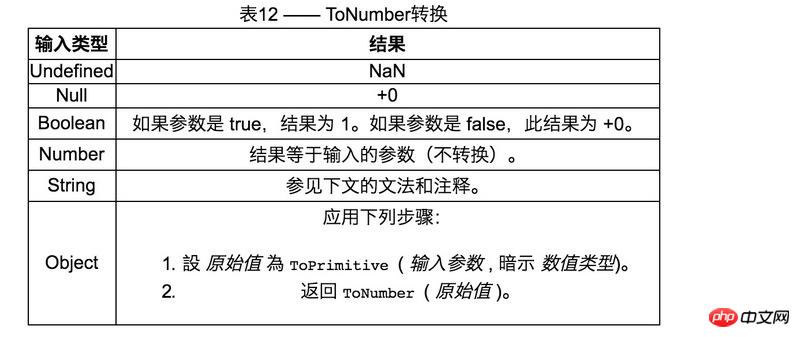This time I will bring you js implicit type conversion Detailed explanation of the steps to use, what are the precautions when using js implicit type conversion, the following is a practical case, let’s take a look one time.
I believe that when you first start to understand js, you will encounter the situation where 2 == '2', but 1 2 == 1 '2' is false. At this time, you should be in a state of confusion, and you have to lament that the flexibility of js's weak types is outrageous, and the implicit type conversion is so caught off guard. Judging from the actual situation, there are still many cases where implicit type conversion is involved intentionally or unintentionally. Since you want to use it, you need to master its principles. It is important to know its why and it is even more important to know its why.
Variable types of js
JavaScript is a weakly typed language, which means that JavaScript variables do not have predetermined types.
And the type of the variable is the type of its value. In other words, the current type of a variable is determined by its value. To exaggerate, a string one second may be an array the next. In addition, when performing certain operations, variables can undergo type conversion. The one we actively perform is explicit type conversion, and the other is implicit type conversion. For example:
var a = '1';
typeof a;//string
a =parseInt(a); //显示转换为number
typeof a //number
a == '1' //true
Copy after login
The characteristics of weak types not only bring us convenience, but also cause us trouble. To seek advantages and avoid disadvantages, the prerequisite for making full use of this feature is to master the principle of type conversion. Let's take a look at it together.
The two common types of data types:
Primitive type
Undefined, Null, String, Number, Boolean
Reference type
object
#In addition, there is a new Symbol in es6, which we will not discuss first. For these five primitive types, you may not be able to think of them all when you ask a sudden question. There is no need to memorize them by rote. You can just think of common variables and their corresponding values.
| 0 |
Number |
##'' | String |
false | Boolean |
null | Null |
undefined | Undefined |
对于不同的数据格式转换规则是不同的,我们需要分别对待。
转换规则
既然是规范定义的规则,那就不要问为什么了,先大致看一下,争取记住。是在不行经常翻翻看看大佬的博客es5规范。转换有下面这么几类,我们分别看一下具体规范。(这部分转换规则,完全可以跳过去,看到下面的实例再回头看应该更容易接受一些)
ToPrimitive(转换为原始值)
ToPrimitive 运算符接受一个值,和一个可选的 期望类型 作参数。ToPrimitive 运算符把其值参数转换为非对象类型。如果对象有能力被转换为不止一种原语类型,可以使用可选的 期望类型 来暗示那个类型。根据下表完成转换

这段定义看起来有点枯燥。转换为原始值,其实就是针对引用数据的,其目的是转换为非对象类型。
如果已经是原始类型,当然就不做处理了
对于object,返回对应的原始类型,该原始类型是由期望类型决定的,期望类型其实就是我们传递的type。直接看下面比较清楚。
ToPrimitive方法大概长这么个样子具体如下。
/**
* @obj 需要转换的对象
* @type 期望转换为的原始数据类型,可选
*/
ToPrimitive(obj,type)
Copy after login
type可以为number或者string,两者的执行顺序有一些差别
string:
调用obj的toString方法,如果为原始值,则返回,否则下一步
调用obj的valueOf方法,后续同上
抛出TypeError 异常
number:
调用obj的valueOf方法,如果为原始值,则返回,否则下一步
调用obj的toString方法,后续同上
抛出TypeError 异常
其实就是调用方法先后,毕竟期望数据类型不同,如果是string当然优先调用toString。反之亦然。
当然type参数可以为空,这时候type的默认值会按照下面的规则设置
该对象为Date,则type被设置为String
否则,type被设置为Number
对于Date数据类型,我们更多期望获得的是其转为时间后的字符串,而非毫秒值,如果为number,则会取到对应的毫秒值,显然字符串使用更多。
其他类型对象按照取值的类型操作即可。
概括而言,ToPrimitive转成何种原始类型,取决于type,type参数可选,若指定,则按照指定类型转换,若不指定,默认根据实用情况分两种情况,Date为string,其余对象为number。那么什么时候会指定type类型呢,那就要看下面两种转换方式了。
toNumber
某些特定情况下需要用到ToNumber方法来转成number
运算符根据下表将其参数转换为数值类型的值

对于string类型,情况比较多,只要掌握常见的就行了。和直接调用Number(str)的结果一致,这里就不多提了,主要是太多提不完。
需要注意的是,这里调用ToPrimitive的时候,type就指定为number了。下面的toString则为string。
toString
ToString 运算符根据下表将其参数转换为字符串类型的值:
其实了解也很简单,毕竟是个规范,借用大佬一张图:

虽然是需要死记的东西,还是有些规律可循的。
对于原始值:
Undefined,null,boolean
直接加上引号,例如'null'
number 则有比较长的规范,毕竟范围比较大
常见的就是 '1' NaN则为'NaN' 基本等同于上面一条
对于负数,则返回-+字符串 例如 '-2' 其他的先不考虑了。
对象则是先转为原始值,再按照上面的步骤进行处理。
valueOf
当调用 valueOf 方法,采用如下步骤:
调用ToObject方法得到一个对象O
原始数据类型转换为对应的内置对象, 引用类型则不变
调用该对象(O)内置valueOf方法.
不同内置对象的valueOf实现:
对照代码更清晰一点
var str = new String('123')
//123
console.log(str.valueOf())
var num = new Number(123)
//123
console.log(num.valueOf())
var date = new Date()
//1526990889729
console.log(date.valueOf())
var bool = new Boolean('123')
//true
console.log(bool.valueOf())
var obj = new Object({valueOf:()=>{
return 1
}})
//依赖于内部实现
console.log(obj.valueOf())Copy after login
运算隐式转换
前面提了那么多抽象概念,就是为了这里来理解具体转换的。
对于+运算来说,规则如下:
+号左右分别进行取值,进行ToPrimitive()操作
分别获取左右转换之后的值,如果存在String,则对其进行ToString处理后进行拼接操作。
其他的都进行ToNumber处理
在转换时ToPrimitive,除去Date为string外都按照ToPrimitive type为Number进行处理
说的自己都迷糊了快,一起结合代码来看一下
1+'2'+false
Copy after login
左边取原始值,依旧是Number
中间为String,则都进行toString操作
左边转换按照toString的规则,返回'1'
得到结果temp值'12'
右边布尔值和temp同样进行1步骤
temp为string,则布尔值也转为string'false'
拼接两者 得到最后结果 '12false'
我们看一个复杂的
var obj1 = {
valueOf:function(){
return 1
}
}
var obj2 = {
toString:function(){
return 'a'
}
}
//2
console.log(1+obj1)
//1a
console.log('1'+ obj2)
//1a
console.log(obj1+obj2)Copy after login
不管多复杂,按照上面的顺序来吧。
左边就不说了,number
右边obj转为基础类型,按照type为number进行
先调用valueOf() 得到结果为1
两遍都是number,则进行相加得到2
1+obj2
左边为number
右边同样按照按照type为number进行转化
调用obj2.valueOf()得到的不是原始值
调用toString() return 'a'
依据第二条规则,存在string,则都转换为string进行拼接
得到结果1a
obj1+obj2
两边都是引用,进行转换 ToPrimitive 默认type为number
obj1.valueOf()为1 直接返回
obj2.valueOf()得到的不是原始值
调用toString() return 'a'
依据第二条规则,存在string,则都转换为string进行拼接
得到结果1a
到这里相信大家对+这种运算的类型转换了解的差不多了。下面就看一下另一种隐式类型转换
== 抽象相等比较
这种比较分为两大类,
相同的就不说了,隐式转换发生在不同类型之间。规律比较复杂,规范比较长,这里也不列举了,大家可以查看抽象相等算法。简单总结一句,相等比较就不想+运算那样string优先了,是以number优先级为最高。概括而言就是,都尽量转成number来进行处理,这样也可以理解,毕竟比较还是期望比较数值。那么规则大概如下:
对于x == y
-
如果x,y均为number,直接比较
没什么可解释的了
1 == 2 //false
Copy after login
-
如果存在对象,ToPrimitive() type为number进行转换,再进行后面比较
var obj1 = {
valueOf:function(){
return '1'
}
}
1 == obj2 //true
//obj1转为原始值,调用obj1.valueOf()
//返回原始值'1'
//'1'toNumber得到 1 然后比较 1 == 1
[] == ![] //true
//[]作为对象ToPrimitive得到 ''
//![]作为boolean转换得到0
//'' == 0
//转换为 0==0 //trueCopy after login
-
存在boolean,按照ToNumber将boolean转换为1或者0,再进行后面比较
//boolean 先转成number,按照上面的规则得到1
//3 == 1 false
//0 == 0 true
3 == true // false
'0' == false //true
Copy after login
-
如果x为string,y为number,x转成number进行比较
//'0' toNumber()得到 0
//0 == 0 true
'0' == 0 //true
Copy after login
相信看了本文案例你已经掌握了方法,更多精彩请关注php中文网其它相关文章!
推荐阅读:
前端中排序算法实例详解
JS中使用接口步骤详解
The above is the detailed content of Detailed explanation of steps to use js implicit type conversion. For more information, please follow other related articles on the PHP Chinese website!





